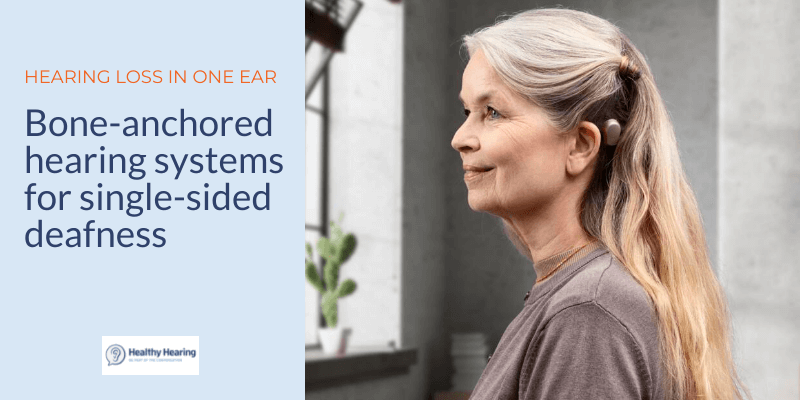|
www.HealthyHearing.com |
I have single-sided deafness. Will a bone-anchored hearing device help me?
Contributed by Madeleine Burry You can be born with single-sided deafness (aka unilateral hearing loss), or develop it at any point in your life. Losing hearing in one—not both—ears affects more than just your ability to hear. You also may have difficulty knowing where sounds are coming from and how loud they are, and have trouble holding a conversation in a noisy environment. There are several treatment options for hearing loss in one ear, and most people start out with a CROS or BiCROS hearing aid system. Both these options require wearing a device on both ears (not just the one with hearing loss). That can leave people feeling taken aback.
People will “get this puzzled look on their face,” when you present them with CROS solutions, which are devices that go in both ears, says Gail Leininger, AuD, CCC-A, an auditory technical specialist for Oticon Medical. Why put a device in both ears, when only one has a problem? “Many patients benefit from CROS solutions and like them,” she says — but for patients who don’t derive benefits or don’t like the experience, bone-anchored hearing systems are a great alternative, she says. What are bone-anchored hearing systems, anyway?Bone-anchored hearing devices are implantable devices that stimulate the inner ear through the bone. The tiny device is implanted in the mastoid bone—located behind the ear—on the affected side, Leininger explains. This is a surgical procedure, which can be done either with local or general anesthesia. Over a few months, the bone integrates with the implanted device. When the integration is complete, you’ll see a fitting professional who will attach and program the processor, Leininger says. The sound processor will work to pick up sounds, and send them as vibration to the inner ear and hearing nerve via the implant. “The reason why patients like bone anchor devices, is it's just one device, one processor solution, addressing the issue that they have, which is not hearing sound from that side of their head or their body,” Leininger says. “It sounds seamless to them when sound comes to the side with SSD, and it just transmits through the skull to that normal hearing ear on the opposite side,” she added. One woman's experience: 'I hear better, period.'Former Texas teacher Debbie Dobbs lost hearing in one ear when she was young, after having the mumps, one of many infections linked to hearing loss. “I didn’t want to be different from the other children and chose not to tell them about my single-sided deafness (SSD),” Dobbs recalls. “However, this resulted in other people thinking I was not listening or didn’t care." In adulthood, she became more transparent—friends and family knew to sit by her right (not left) ear, and face her so she could lipread. Still, without her SSD treated, Dobbs sometimes “felt overloaded with too much noise.” She’d sometimes “needed to tune out, put in an earplug, or retreat to a quieter environment.” For Dobbs, the CROS wasn’t effective—it “interfered with my good right ear,” and she wound up removing them. The solution that ultimately worked for Dobbs was getting a Ponto hearing system made by Oticon Medical. (Another similar device in the US is the BAHA by Cochlear.) “I hear better—period,” says Dobbs. Can anyone with single-sided deafness get BAHS?There are not many people who can’t get a bone-anchored hearing system. But keep in mind that bone condition matters: An ear-nose-throat doctor will assess the condition and thickness of the bone. If someone has osteogenesis imperfecta or has had radiation, this procedure might not be appropriate, Leininger says. Once an implant is in place, it’s set for life, Leininger says. (If there’s a trauma to your head, it could become dislodged. In that case, a new device would need to be re-implanted, she notes.) And while the procedure is reversible (you can get the implant removed), that’s rare, per UCI Health. That’s because the device leads to a great experience. Before you commit, test driveIf you are interested in a bone-hearing device, talk to your doctor or hearing care provider. It’s understandable that you might feel leery about getting a device implanted without knowing if it’ll suit your particular needs and preferences. If that’s the case, you can ask your doctor for a "test drive," which involved wearing the processor attached to a headband or softband. Depending on your doctor, you may be able to do an in-office demo or even take it home overnight to test out, Leininger says. Bottom lineThere are other, non-surgical treatments available for one-sided hearing loss. But many people who get this device appreciate it. “Wearing a bone-anchored hearing system will improve the quality of your life,” Dobbs says. It’s not a total panacea, she notes—loud environments are still a challenge for her. But small groups and large lecture halls are great. “This is the best thing I’ve ever done… to improve my hearing in a world where sound is a priority,” Dobbs says. Madeleine Burry
Related Help Pages:
Hearing aids Types of hearing aids Technology Accessories Cochlear implants Bone-anchored hearing systems
|
Featured clinics near me
Earzlink Hearing Care - Reynoldsburg
7668 Slate Ridge Blvd
Reynoldsburg, OH 43068

Find a clinic
We have more hearing clinic reviews than any other site!



 Madeleine Burry is a Brooklyn-based freelance writer and editor. She's written about health for several online publications, including Women's Health, Prevention, Health, Livestrong and Good Housekeeping. You can follow her on Twitter @lovelanewest.
Madeleine Burry is a Brooklyn-based freelance writer and editor. She's written about health for several online publications, including Women's Health, Prevention, Health, Livestrong and Good Housekeeping. You can follow her on Twitter @lovelanewest.